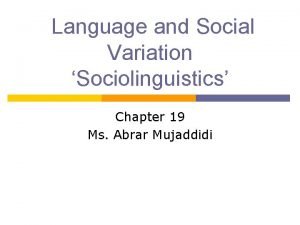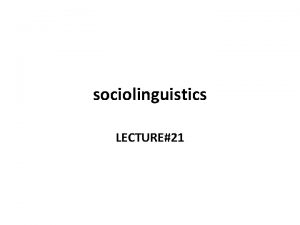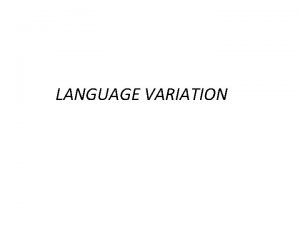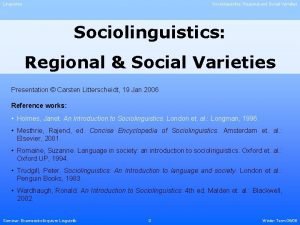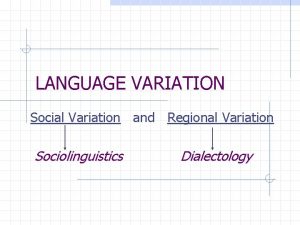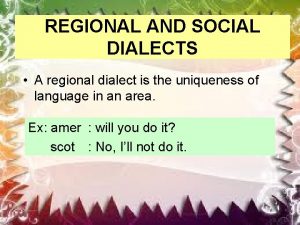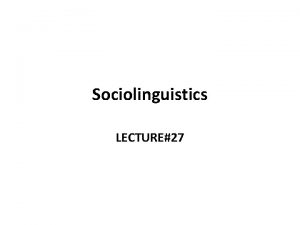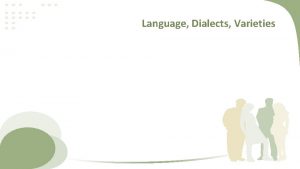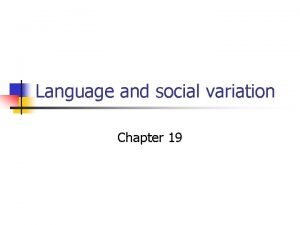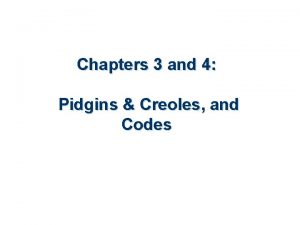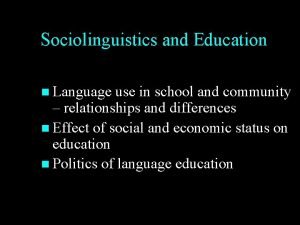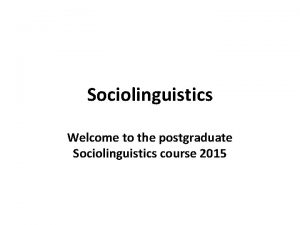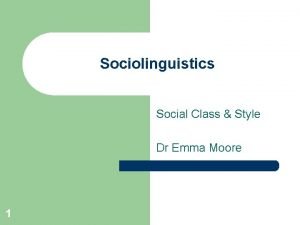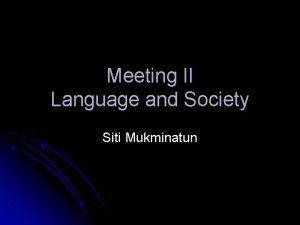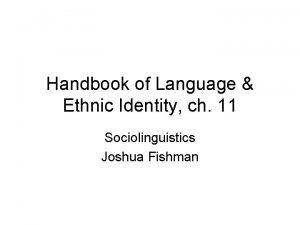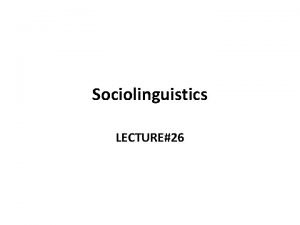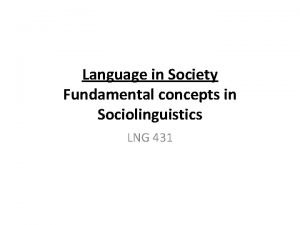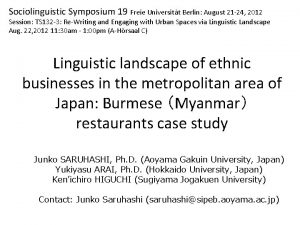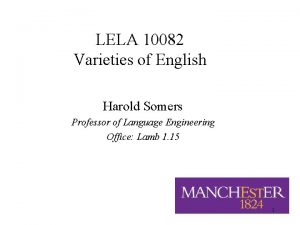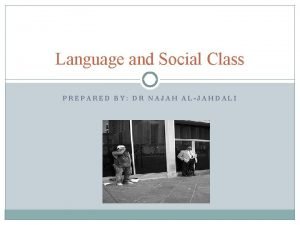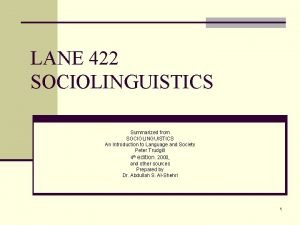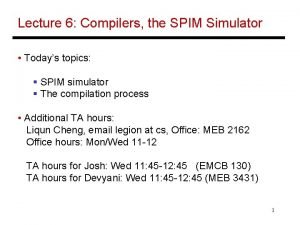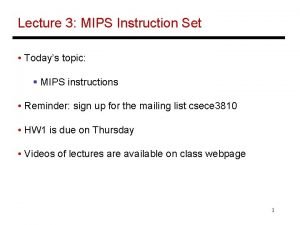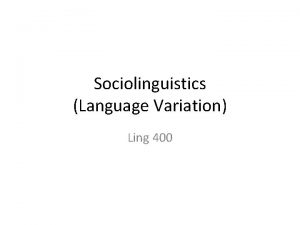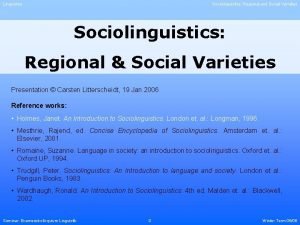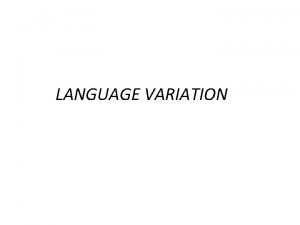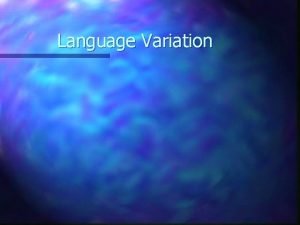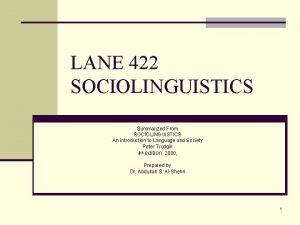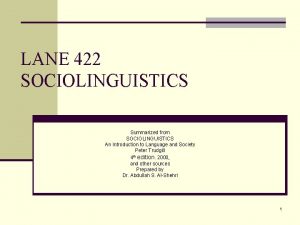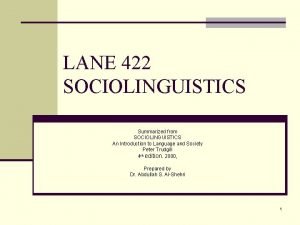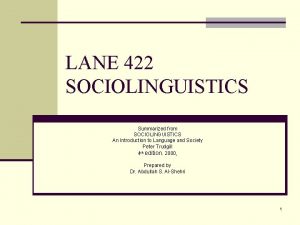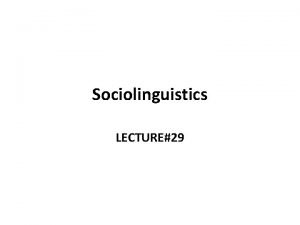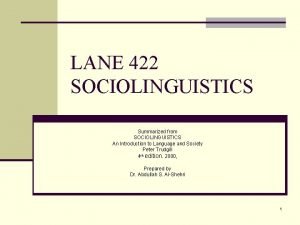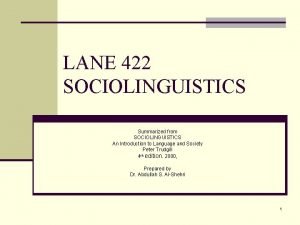Todays topics 1 Language and Social Variation Sociolinguistics












































- Slides: 44

Today’s topics 1 Language and Social Variation: Sociolinguistics. Social dialects. Education and occupation. Social markers. Speech style and style-shifting. Prestige. Speech accommodation. Register and jargon. Slang. Social barriers. Vernacular language. You can study these topics in: George Yule: Chapter 19.

Language and Social Variation SOCIOLINGUISTICS Course title: Introduction to Linguistics II

Speech community 3 It is a group of people who share a set of norms and expectations regarding the use of language. The study of the linguistic features that have social relevance for participants in those speech communities is called sociolinguistics.

Language and Social Variation SOCIAL DIALECTS Course title: Introduction to Linguistics II

Social dialects 5 The study of social dialects is mainly concerned with speakers in towns and cities. Social class is what defines groups of speakers as having something in common. Two main groups: Middle class and working class. E. g. a social dialect or sociolect is ‘working-class speech’.

Social dialects: examples 6 Pronunciation: home as: /heim/ (rhyming with name) by lower-working-class speakers /houm/ (rhyming with foam) by lower-middle-class speakers in Edinburgh, Scotland. Word: Vegetables (’ 50 s middle class) vs. greens (’ 50 s lower-middle). Grammatical structure: I ain’t finished yet (working-class) vs. I haven’t finished yet.

Variables 7 Social variable: Class. Linguistic variable: pronunciation, word or grammatical structure under examination.

Language and Social Variation EDUCATION AND OCCUPATION Course title: Introduction to Linguistics II

Idiolect 9 The individual way of speaking. Occupation and socio-economic status affect our sociolect.

Labov’s experiment 10 Took place in New York, 1966. Post-vocalic /r/ by shop assistants at 3 shops: Saks Fifth Avenue, Macy’s and Klein’s. Labov’s question: ‘Where are the women’s shoes? ’ Answer: (having two instances of post vocalic /r/) Fourth floor. Outcome: The higher the socio-economic status of the store, the more /r/ sounds were produced; the lower the status, the fewer /r/ sounds were produced.

Trudgill’s experiment 11 Took place in Reading, England, 1974. Middle class speakers dropped post-vocalic /r/, whereas working class speakers didn’t. Working class people also: (a) dropped initial /h/, e. g. in (h)ouse, (h)ello, (h)ungry, etc. (b) substituted /n/ for final /g/ as in writin(g), playin(g) etc. (c) used double negation as in “They don’t know nothing them kids”.

Social markers 12 How the use of a particular linguistic feature marks a speaker as a member of a particular social group, whether s/he realises it or not. Exercises 1 -3

Language and Social Variation SPEECH STYLE AND STYLE-SHIFTING Course title: Introduction to Linguistics II

Style-shifting 14 A change from one type of style to the other by a speaker. Formal vs. informal style. Consider the following examples: I should be grateful if you made less noise. Please be quiet. Shut up! We were rather dismayed by his lack of response to our invitation. We were upset that he didn’t call us to say he wouldn’t come.

Labov’s experiment 15 Labov also studied style-shifting. Middle-class speakers are much more likely to shift their style of speaking significantly in the direction of the upper middle class style when they are using a careful style.

Prestige forms 16 When speakers from a middle-status group use a prestige form associated with a higher-status group in a formal situation, they have a tendency to overuse the form: ‘more’ is seen as ‘better’ in their formal speech style.

Language and Social Variation PRESTIGE Course title: Introduction to Linguistics II

Overt prestige 18 Prestige forms provide a way of explaining the direction certain individuals change their speech. Overt prestige: When individuals change their speech in the direction of a form that is more frequent in the speech of those perceived to have higher social status, or status that is generally recognised as ‘better’ or more positively valued in the larger community. E. g. use of postvocalic /r/ in the speech of middle-status speakers.

Covert prestige 19 Covert prestige: The ‘hidden’ status of a speech style as having positive value. It explains why certain groups do not exhibit style-shifting to the same extent as other groups. Lower working class speakers do not exhibit style shifting. The answer may be that: They value features of their speech in that they mark them as members of their social group. They value group solidarity more than upward mobility. E. g. I ain’t doin’ nuttin’

Language and Social Variation SPEECH ACCOMMODATION Course title: Introduction to Linguistics II

Speech accommodation: definition 21 Variation in speech style is a function of: Speaker’s social status. Attention to speech. The speaker’s perception of their listeners: known as ‘audience design’ or speech accommodation. Our ability to modify our speech style toward or away from the perceived style of the person(s) we are talking to.

Convergence – divergence: definition 22 When speech accommodation aims at reducing social distance between speaker and addressee, it is described as convergence. When the speaker wishes to emphasise social distance, the process is called divergence.

Divergence: example 23 Teenager: I can’t do it, sir. Teacher: Oh, come on, if I can do it, you can too. Teenager: Look, I cannae dae it so …

Convergence: example 24 Teenager asking to see some holiday photos from his friend (1) and his friends mother (2): 1. Teenager: C’ mon Tony, gizzalook. 2. Teenager: Excuse me. Could I have a look at your photos too, Mrs Hall?

Language and Social Variation REGISTER AND JARGON Course title: Introduction to Linguistics II

Register: definition 26 A register is a conventional way of using language that is appropriate in a specific context, which may be identified as: situational (e. g. in church), occupational (e. g. among doctors or lawyers), or topical (e. g. talking about language, sports, etc. ).

Jargon: definition 27 One of the defining features of a register is the use of jargon, which is special technical vocabulary associated with a specific area of work or interest and used by those inside established social groups of professional status. E. g. suffix, witness, nonsteroidal medication, etc. Exercises 4 -5

Language and Social Variation SLANG Course title: Introduction to Linguistics II

Slang: definition 29 It is more typically used by those who are outside established higher-status groups. Slang or ‘colloquial’ speech describes words or phrases that are used instead of more everyday terms among younger speakers and other groups with special interests.

Slang: examples 30 Slang expressions for “really good” groovy, hip, super awesome, rad, wicked dope, kickass, phat Slang expressions for something being “really bad” the pits a bummer that sucks! www. slang. gr

Taboo terms: definition 31 Words or expressions that are considered offensive, shocking, blasphemous, or indecent (by certain people) and are not supposed to be used are taboo words, i. e. swear words. Examples: What the f… are you doing? You, little b…! You, stupid, f… a…. . ! Exercise 6

Language and Social Variation SOCIAL BARRIERS Course title: Introduction to Linguistics II

Social barriers 33 Social barriers such as discrimination and segregation serve to create marked differences between social dialects. African American English (AAE) or Black English or Ebonics: A variety used by many (not all) African Americans and other speakers (e. g. Puerto Rican groups in NY). It has a number of features which taken together form a distinct set of social markers.

The use of AAE 34 The features of AAE have been stigmatised as ‘bad’ language. There is a general pattern whereby the social practices, especially speech, of dominated groups are treated as ‘abnormal’ by dominant groups who are in charge of defining ‘normal’. AAE has covert prestige among younger speakers in other social groups, especially with regard to pop music.

Language and Social Variation VERNACULAR LANGUAGE Course title: Introduction to Linguistics II

AAVE 36 The form of AAE which has been most studied is usually described as African American Vernacular English (AAVE).

Vernacular: definition 37 It is a general expression for a kind of social dialect, typically spoken by a lower-status group, which is treated as ‘non-standard’ because of marked differences from a socially prestigious variety treated as the standard language.

Features of AAVE 1 38 Consonant cluster simplification: Tes for test, des for desk, gol’ for gold, lef han for left hand, etc. Substitution of initial dental consonants with alveolar stops: Tink for think, dat for that, etc. Dropping the /s/ in possessive genitive and third person singular of simple present tense: John girlfriend for John’s girlfriend, she love him for she loves him, etc.

Features of AAVE 2 39 Absence of plural marker /s/ when plural is indicated otherwise: Two guy for two guys, one of my friend for one of my friends, etc. Double negative: He don’t know nothing, I ain’t afraid of no ghost, etc. ). Absence of the copula verb be when referring to current situation, action, etc. : You crazy, she working now, etc. Use of be in expressing habitual action: The beer be warm at that place, she be late, etc. Exercise 7

Summary 1 40 Sociolinguistics: the study of the linguistic features that have social relevance for participants in those speech communities. Social dialects: whereas the study of regional dialects focuses on people in rural areas, social dialects deal with people in towns and cities. Education and occupation: occupation and socio-economic status affect our sociolect (social dialect). Social markers: how the use of a particular linguistic feature marks a speaker as a member of a particular social group, whether s/he realises it or not.

Summary 2 41 Speech style and style-shifting: A change from one type of style to the other by a speaker. Overt prestige: When individuals change their speech in the direction of a form that is more frequent in the speech of those perceived to have higher social status, or status that is generally recognised as ‘better’ or more positively valued in the larger community. Covert prestige: the ‘hidden’ status of a speech style as having positive value. It explains why certain groups do not exhibit style-shifting to the same extent as other groups.

Summary 3 42 Speech accommodation: Our ability to modify our speech style toward or away from the perceived style of the person(s) we are talking to. When speech accommodation aims at reducing social distance between speaker and addressee, it is described as convergence. When the speaker wishes to emphasise social distance, the process is called divergence. Register: it is a conventional way of using language that is appropriate in a specific context, which may be identified as situational (e. g. in church), occupational (e. g. among doctors or lawyers), or topical (e. g. talking about language, sports, etc. ).

Summary 4 43 Jargon: it is special technical vocabulary associated with a specific area of work or interest and used by those inside established social groups of professional status. Slang: slang or ‘colloquial’ speech describes words or phrases that are used instead of more everyday terms among younger speakers and other groups with special interests. Social barriers: social barriers such as discrimination and segregation serve to create marked differences between social dialects. Vernacular language: a general expression for a kind of social dialect, typically spoken by a lower-status group, which is treated as ‘non-standard’ because of marked differences from a socially prestigious variety treated as the standard language.

Next week. . . 44 Revision. . .
 What is register in sociolinguistics
What is register in sociolinguistics Sociolinguistics definition
Sociolinguistics definition Regional variation in language
Regional variation in language Regional variation in sociolinguistics
Regional variation in sociolinguistics Warsh accent
Warsh accent Sociolinguistics topics for presentation
Sociolinguistics topics for presentation Sociolinguistics topics
Sociolinguistics topics What are regional dialects
What are regional dialects Language and dialect in sociolinguistics
Language and dialect in sociolinguistics Language
Language Direct variation equation
Direct variation equation Examples of direct variation graphs
Examples of direct variation graphs Prediction interval formula
Prediction interval formula What is overt prestige
What is overt prestige Standard language slideshare
Standard language slideshare Pidgin examples
Pidgin examples Sociolinguistics and education
Sociolinguistics and education Language variation
Language variation Variationist sociolinguistics
Variationist sociolinguistics Variationist sociolinguistics
Variationist sociolinguistics Sociolinguistics
Sociolinguistics What is sociolinguistics
What is sociolinguistics Language
Language Ethnicity in sociolinguistics
Ethnicity in sociolinguistics Code switching in sociolinguistics
Code switching in sociolinguistics Register (sociolinguistics)
Register (sociolinguistics) Basic concepts in sociolinguistics
Basic concepts in sociolinguistics Sociolinguistics slideshare
Sociolinguistics slideshare Malihka burmese restaurant
Malihka burmese restaurant Origin of sociolinguistics
Origin of sociolinguistics Linguistic prescriptivism
Linguistic prescriptivism Frozen register
Frozen register Idiolect in sociolinguistics
Idiolect in sociolinguistics Variationist sociolinguistics
Variationist sociolinguistics Idiolect definition
Idiolect definition Social thinking and social influence
Social thinking and social influence Social thinking social influence social relations
Social thinking social influence social relations Language
Language Generations
Generations How was today's class
How was today's class Todays with apostrophe
Todays with apostrophe Todays worldld
Todays worldld Whats todays temperature
Whats todays temperature Todays globl
Todays globl Todays wordlw
Todays wordlw
